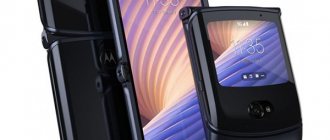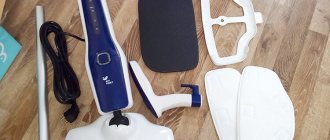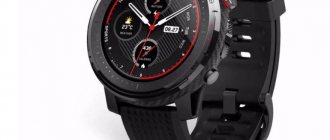The tonometer allows you to measure blood pressure levels and promptly detect malfunctions in the cardiovascular system. Automatic models are the most user-friendly. Thanks to the compressor that pumps air, the patient does not have to do it himself. A high-precision measurement mechanism determines the upper and lower pressure and displays the information on the screen.
Each manufacturer strives to improve the meters they produce, making them more accurate, comfortable to use and multifunctional. Specialists pay special attention to the reliability of the results produced by the tonometer, for which they are constantly improving data processing algorithms. The level of processor and software performance already allows us to say that modern automatic blood pressure monitors have the capabilities of modern computers. That is why we have compiled a rating of automatic tonometers based on their accuracy and functionality.
Rating of automatic blood pressure monitors
In our rating of automatic tonometers, we included wrist and shoulder devices. Accuracy is assessed depending on the accuracy class assigned to the tonometer, the presence of international certificates and opinions of authoritative communities, such as:
- British Hypertension Society (BIHS, https://bihsoc.org/),
- European Society of Arterial Hypertension (ESH, https://www.eshonline.org/),
- American Association for the Advancement of Medical Devices (AAMI, https://www.aami.org/),
- Russian Cardiological Society (RKO, https://www.scardio.ru/).
Which tonometer to choose
Nowadays, few people prefer mechanical models. Their only advantage is their low price. It will be difficult to ensure high accuracy without practice. Modern household tonometers are divided into 2 types:
- Semi-automatic
- Slot machines
Both types can be used at home because they are easy to measure blood pressure. They are designed to allow each user to complete this procedure without assistance. The semi-automatic device measures pressure quite accurately. But it needs to be fixed correctly. A phonendoscope is used for this. You have to pump air into the system yourself, using a special bulb.
It is much easier and more convenient to use an automatic machine. Here it is enough to put the cuff on your arm correctly. In most models, measurement is carried out by pressing one button. The cuff is placed on the shoulder or wrist, depending on the type of device. It is recommended to use the wrist ones for young people; for the elderly, the forearm ones are preferable.
We do not consider mechanical and professional devices here. To work with them you need experience and medical knowledge, and professional ones are equipped with a set of specific functions that the average person does not need at all.
Some of the most popular brands are And and Omron, which were the first to produce medical measuring instruments for home use.
Selecting a tonometer.
There are 3 types of tonometers: automatic, semi-automatic and mechanical. Before you purchase one of them, you should familiarize yourself with the main advantages of each.
Features of a mechanical tonometer
The OMRON mechanical tonometer from Japan is one of the most common, and also has a longer history of use, since other tonometers appeared somewhat later.
How it works : when you stop pumping air into the cuff, having reached the desired mark on the scale, blood flow in the brachial artery stops. And when the air begins to slowly deflate, the artery opens a little and you begin to hear Korotkoff sounds, named after the surgeon who invented the method of listening to the pressure in the artery using a stethoscope.
Features of a semi-automatic tonometer
A semi-automatic tonometer has a working principle similar to mechanical tonometers, with the exception that here you only need to pump air, and it will do the rest itself. You don't have to listen to the tones, but just wait for the result to appear on the screen. In order to buy a semi-automatic omron tonometer, you should consult with the specialists of our store.
Features of an automatic tonometer
Wrist blood pressure monitors are the easiest to use. In order to use an automatic tonometer or watch tonometer , you need to put it on your wrist and just press a button, it will do all the calculations itself and display the result on the display.
When choosing a tonometer, you should take into account the characteristics of each of the presented types, and you can also consult with your doctor and find out from him which tonometer will be most suitable. tonometers.
Tonometers are classified as “mechanical”, “semi-automatic” and “automatic”. “Automatic” are available “on the shoulder” and “on the wrist”.
A long time ago, pressure was measured with a mercury tonometer, which was the most accurate, because... blood pressure is measured in millimeters of mercury. Mechanical tonometers replaced mercury tonometers. They are more compact, safer (no mercury) and just as accurate as mercury ones.
Mechanical tonometers CS Medica: The person measuring everything needs to do: pump air into the cuff and deflate it, marking the number on the pressure gauge scale when pulsation begins (this is systolic pressure) and the number when it stops (this is diastolic pressure). The principle of operation of a mechanical tonometer: when the air pressure in the cuff becomes higher than the blood pressure in the vessels, blood flow in the brachial artery stops. We do not hear any tones in the stethoscope tube. Then, when the air descends, the lumen of the artery opens slightly, blood flow is restored, and Korotkoff sounds appear in the tube. After a few seconds, the air pressure in the cuff drops enough that the artery opens completely and the noise disappears. Korotkov Nikolai Sergeevich is a Russian surgeon who, at the beginning of the 20th century, was the first to invent an auscultatory method for measuring blood pressure, that is, by listening with a stethoscope. Previously, this was done by palpation (with the help of fingers - how we feel the pulse).
Semi-automatic tonometers: In these devices, the pressure, just like in mechanical ones, is pumped up using a bulb. But then the tonometer does everything itself: it releases air and displays the result on the screen. If pumping up a bulb doesn’t bother you, then you can buy such a device; it’s cheaper than a full automatic machine.
Automatic blood pressure monitors: Put on the cuff. Press the big button. All! The automatic tonometer will do the rest of the work for the person: it will pump air into the cuff, deflate it and show the result. The operating principle of semi-automatic and automatic tonometers: these devices use the oscillometric method of measuring pressure. Fluctuations (oscillations) of blood pressure in the artery of the arm, which occur when air is released, cause air vibrations in the cuff placed on the arm, which is recorded by a special sensor of the device and then processed by the built-in microprocessor. Some models, such as the Omron M6, have two sensors to improve measurement accuracy. Two sensors help measure pressure even with pulsating arrhythmia!
Which blood pressure monitor should you choose? Many people believe that only a mechanical tonometer shows accurate pressure. But, as practice shows, a good automatic transmission shows exactly the same results as a manual transmission. Checked! Measuring blood pressure with a mechanical tonometer is a medical procedure! And here every granny of 70-80 years old thinks that there is nothing complicated about this. Ideally: mechanical blood pressure monitors should be sold only after presentation of a diploma from a medical school. Reason: A study was conducted among people who measured their blood pressure with a mechanical tonometer. Result: 75% of these measurers incorrectly identified Korotkoff tones. You can come to terms with this, but only if another person measures your blood pressure with such a tonometer. But people manage to measure themselves! And one pumping of the bulb already increases the pressure by 10-15 mmHg! Add: older people have problems with vision, hearing... they either saw or heard... Or they vented the air too quickly and did not catch the first and last digits. When measuring pressure, some people rely not on tones, but on the vibrations of the pressure gauge needle. But this is not true! In addition, when the pulse filling is weak, and this often happens in the elderly, there may be complete silence in the tube. And then the person gets scared, and his blood pressure rises even more.
Reasons why we do not recommend purchasing a mechanical tonometer for “non-medics”: - The measurement should be carried out by a specially trained person. — 75% of those measuring incorrectly determine the pressure. — Decreased hearing and vision increase the likelihood of errors. — Measuring your own pressure increases it by 10-15 mm Hg — Incorrect position of the pressure gauge increases the likelihood of error. — Excessive inflation of air into the cuff and rapid deflation affect the correctness of the result. — When the pulse filling is weak, no tones are heard in the tube. — Repeated pumping of air into the cuff during the measurement process in order to catch the first and last tones greatly distorts the result. — A mechanical tonometer must be calibrated (adjusted to the standard) annually at a service center.
Studies have shown that the error of automatic tonometers is only 3-5 mmHg. This number is not significant at all! In addition, they are designed specifically for home use by people without medical education. Let’s compare “semi-automatic” and “automatic”:
A person also pumps up a semi-automatic machine on his own, which means this is again physical activity, which can affect the measurement result. If we talk about a very elderly person, then it is difficult for him to work with a pear: the muscle strength is no longer the same. Isn’t it easier to buy him a really light and easy-to-use device? I mean automatic. Omron has a 5 year warranty!
About wrist blood pressure monitors: They are as accurate as shoulder blood pressure monitors, but: - when measuring, you need to accurately place your hand at the level of your heart - support the hand being measured with your other hand - practice has shown that wrist devices are best used by people under about 40 years of age. Read more: With age, blood vessels wear out, and the vessels of the wrist are faster because they are thin. The elasticity of their walls decreases. And for accurate measurements they need to be in good condition. Over the course of a lifetime, an elderly person can “accumulate” various microtraumas in the area of the wrist joint (sprains, bruises, etc.). This is a contraindication to the use of wrist devices. With age, various deformations of the joint, “bones,” occur, which leads to incorrect application of the device cuff. The brachial artery is more “hardy” in this regard, which means it is better suited for capturing oscillations. About atherosclerosis. Since atherosclerosis affects large and medium-sized arteries, the carpal arteries are not one of them.
And now the choice . You must first answer the following questions for yourself: - what age is the device for? If for a young or middle-aged person, you can buy both a shoulder and wrist one. If for an elderly person - only the shoulder. - are there any interruptions in the heartbeat (ari or “I don’t know”, then we buy only with the intelligent measurement function. If not, then any. - measure the circumference of the arm. The cuffs are: 22-32 cm; 22-42 cm; enlarged; pediatric. - how many people will use the tonometer? If two, then we recommend “with memory for two." - Do you need to remember the date and time of measurement? If yes, then choose models that record the date and time of measurement. Write down or remember the answers to these questions and let us know to the seller. He will help you make a choice! And one more small point: the device is powered by electricity. All “automatic machines” can operate from a 220V network or from batteries. There are different configurations, consult with the seller to choose the optimal model.
The Omron tonometer line includes a unique “Comfort” Cuff. This cuff is designed specifically for comfortable pressure changes. The main part of the cuff is not soft, as we are used to seeing, but semi-rigid. The cuff is put on the hand in a few seconds; not only that, it also puts less pressure on the hand, which many people will really like. Look at the picture:
What is the intelligent pressure measurement function: with each pressure measurement, the device itself determines the optimal air injection level. It measures pressure already in the process of air injection, analyzes the pulse wave in detail and, in the case of arrhythmia, selects the fragment with the most stable pulsation so that the measurement result is as accurate as possible.
Ideal blood pressure measurement: - Blood pressure should be measured 1-1.5 hours after eating. — Do not drink strong coffee or tea for an hour before the measurement, as the caffeine they contain increases blood pressure. — Do not smoke for an hour before the measurement, as the influence of a cigarette causes vasoconstriction and an increase in blood pressure. — the measurement is carried out after a mandatory 5-minute rest. It is enough to just sit on a chair and breathe calmly. — after physical work or emotional shock, you need to calm down within half an hour. — When measuring with a shoulder tonometer, the hand should be on the table so that the middle of the cuff is at the level of the heart. When measuring with a wrist device, the wrist should be kept at the level of the heart, supporting the hand with the other hand. Every 5 cm of displacement of the middle of the cuff above or below the level of the heart leads to an overestimation (if the arm is lowered) or an underestimation of the pressure (if the arm is raised) - the cuff should not be too tight and should not dangle on the arm. — there is no need to talk during the measurement, as this affects the result. - a person should sit on a chair with support for his back: tension while sitting, a back bent like a wheel increases blood pressure. In the latter case, intra-abdominal pressure increases and large vessels are compressed. — do not cross your legs, because otherwise large arteries will also be pinched, which increases blood pressure. — when measured with a brachial tonometer, the cuff should be 2 cm above the elbow bend so as not to compress the brachial artery. — measurements on thin clothes (for the shoulder) are allowed. — when measuring with a wrist tonometer, the wrist must be freed from clothing and the watch must be removed.
When purchasing, remember that pressure numbers are influenced by many factors. The most correct measurement will be at home, at rest, and not after a run to the store.
Possible deviations during measurement and their reason: - the pressure on the left and right hands is different. If the difference exceeds 10 mm Hg, then it should be measured on the hand with higher numbers. If there is a big difference, pay attention to vascular pathology: narrowing, plaques, blood clots. See a doctor and get examined! — different indicators every 10 minutes. Pressure is not a constant value. We talked, sat down, stood up, walked around, ate, got nervous - all this affects the blood pressure. For this reason, doctors recommend taking three measurements at intervals of 2-3 minutes and taking the average value. Many modern tonometers have this function: the device itself calculates the average pressure. It is very important, if you measure your blood pressure 3 times in a row, to take this 2-3 minute break between measurements. The vessels must “rest” from compression and recover. Otherwise, the results will be incorrect. - and in the clinic there are other indicators. Because it is impossible to create conditions for correct blood pressure measurement in a clinic. At a doctor's appointment, you are, one way or another, nervous. There is even such a term as “white coat syndrome”. Therefore, measuring blood pressure in a quiet home environment is more accurate. — I want a Japanese blood pressure monitor, but only Chinese ones are sold! Reason: cheap labor. If it were assembled in Japan, it would cost twice as much. There is a huge difference between Chinese artisanal production and factory production. The assembly of Omron tonometers takes place under the strict control of Japanese specialists. The quality of tonometers is evidenced by certificates from the Ministry of Health and the State Standard. And the service life of the devices reaches 20 years.
There are 3 types of tonometers: automatic, semi-automatic and mechanical. Before you purchase one of them, you should familiarize yourself with the main advantages of each.
Features of a mechanical tonometer
The OMRON mechanical tonometer from Japan is one of the most common, and also has a longer history of use, since other tonometers appeared somewhat later.
How it works : when you stop pumping air into the cuff, having reached the desired mark on the scale, blood flow in the brachial artery stops. And when the air begins to slowly deflate, the artery opens a little and you begin to hear Korotkoff sounds, named after the surgeon who invented the method of listening to the pressure in the artery using a stethoscope.
Features of a semi-automatic tonometer
A semi-automatic tonometer has a working principle similar to mechanical tonometers, with the exception that here you only need to pump air, and it will do the rest itself. You don't have to listen to the tones, but just wait for the result to appear on the screen. In order to buy a semi-automatic omron tonometer, you should consult with the specialists of our store.
Features of an automatic tonometer
Wrist blood pressure monitors are the easiest to use. In order to use an automatic tonometer or watch tonometer , you need to put it on your wrist and just press a button, it will do all the calculations itself and display the result on the display.
When choosing a tonometer, you should take into account the characteristics of each of the presented types, and you can also consult with your doctor and find out from him which tonometer will be most suitable.
Tonometer AND UA-888 Economy. General characteristics
The AND UA-888 tonometer includes a standard cuff for an upper arm circumference of 22-32 cm and an adapter. The device is equipped with memory cells for 30 measurements. An important function in addition to measuring blood pressure for this model is arrhythmia recognition*. Additionally, the device has a WHO color diagnostic scale**. Easy to operate with one button.
The tonometer model has connectors on the body for a power adapter and a cuff.
So, if necessary, you can change the cuff to a child’s one. On the back side there is a compartment for AA batteries. *Arrhythmia is a violation of the frequency and regularity of heart contractions, which, as it develops, leads to disruption of the proper functioning of the heart and the development of unpleasant sensations.
Arrhythmia is also one of the satellites of the thrombus formation process. **Classification of blood pressure levels according to the WHO scale - a scale of norms and pathologies of blood pressure recognized by the World Health Organization
How to use the tonometer
Any blood pressure measurements, both at home and by a specialist, should be carried out at rest. You cannot move or talk during measurements. It is necessary, if possible, to carry out measurements in a sitting position, place the hand and the device on the table, so that the heart, the measurement site and the tonometer are at the same level.
The cuff must be placed on the shoulder of the left arm and the “start” button must be pressed. Wait until the value “0” appears on the display and only then start measuring by pressing the start button. As soon as the measurement process is completed, the values will appear on the display.
When measuring with a device with a cuff on the wrist, the hand with the device must be placed bent on the chest to achieve the same level of the tonometer. places of measurements and hearts.
The best automatic blood pressure monitors: top 5 models
Omron M3 Expert
Automatic shoulder blood pressure monitor with a large LCD screen and a universal cuff that will suit all family members. The error in measuring pressure here is minimal - 3 mm Hg. Art., and the accuracy of the pulse value is 5%. The device can be powered by four AAA batteries or from the mains; a corresponding adapter is included. The tonometer can detect arrhythmia and has a memory for 60 measurements.
Omron M3 Expert uses the patented Intellisense system, which takes into account the patient's vascular condition and calculates pressure based on heart rate, time and oscillations. It selects the correct combination from a variety of blood pressure options, resulting in highly accurate measurements.
Omron M2 Basic
The tonometer comes with a medium cuff 22-32 cm, an adapter for connecting to the mains, a case and a set of four AAA batteries. The error here is the same as that of the Omron M3 Expert model - 3 mm Hg. for pressure and 5% for pulse. The device's memory can store the latest 30 results. The measurement also uses proprietary Intellisense technology.
B.Well PRO-35 (M-L)
An inexpensive but good blood pressure monitor from B.Well can be purchased for 1,690 rubles - this is a small price for a device with high accuracy (3 mm Hg and 5%). When measuring pressure, the device uses the classic algorithm for releasing air from the Intellect Classic cuff. The kit includes an adapter for connecting to the network and a universal cuff (22-42 cm) of a cone shape.
Microlife BP A6 PC
This is an expensive, but very functional blood pressure monitor for older people. Microlife memory can store up to 99 results, dividing them into two profiles: for evening and morning measurements or for two different users. Thanks to AFIB technology, the tonometer can detect the risk of stroke - atrial fibrillation. And MAM technology allows you to achieve maximum measurement accuracy: the device analyzes three consecutive results and reports the correct pressure value.
The model can be powered by batteries or mains. The set includes a classic cuff 22-42 cm and an adapter for a socket. Standard error: 3 mm Hg. and 5% for pressure and pulse, respectively.
Tonometer AND UB-202
Judging by the reviews, this is a convenient and compact device for measuring pressure on the wrist. The model from the Russian company AND is suitable for older people who monitor their blood pressure and measure it themselves: the tonometer can be easily attached to the arm without outside help.
Its accuracy is the same as other models from our rating. Memory capacity: 90 measurements. There is a “guest” mode, which will allow you not to save unscheduled measurements, and an arrhythmia sensor. The device runs on two AAA batteries.
How to choose an Omron blood pressure monitor?
Measurement Accuracy : The most important attribute of a blood pressure monitor is the accuracy of the measurement. This is the main reason why you buy a blood pressure monitor in the first place. Look at whether the device's results are clinically validated, indicating that the equipment went through a series of tests before it was made available on the market. An authentic product assures you that the blood pressure monitor has been tested and proven to provide accurate and reliable results.
Cuff size : The cuff you wrap around your arm comes in different sizes. Using the correct cuff size makes blood pressure measurements more accurate. This will also give you greater comfort when taking measurements. This is why you need to make sure you have the correct cuff size. Otherwise, incorrect information may be read. When measuring, the cuff should not be too tight or too soft on the arm, but should provide a snug fit.
Digital Display : Blood pressure monitors have digital screens where you can view readings or measurements of your blood pressure. It is important that you can read accurate medical information without any problems. Omron blood pressure monitors feature easy-to-read backlit displays and extra-large numbers to display information clearly.
Read in more detail: Automatic and mechanical tonometer: How to choose?
Device connection. With Omron's latest blood pressure monitors featuring innovative technology, you can now integrate your blood pressure monitor with your smartphone, computer or tablet. You can integrate it with an available app and view the readings on your device. This will also be a very convenient feature for those patients who need to regularly update their doctors about their blood pressure readings.
Semi-automatic blood pressure monitors
Semi-automatic blood pressure monitors also work based on the oscillometric method of measuring blood pressure. Only air is pumped into the cuff manually using a bulb. This is considered the main inconvenience of self-measurement, since the procedure eliminates immobility.
Omron S1 tonometer. General characteristics
In its category of semi-automatic tonometers, this model is optimal in terms of price-quality ratio. The device is easy to use and suitable for independent use. The cuff is inflated manually using a bulb, and the device carries out further manipulations with measurements automatically. There is also no need to deflate the cuff.
The battery life is enough to carry out 1500 measurements.
Omron S1 has a memory for 14 measurements. The advantage of this model is the presence of an indicator of high pressure. If the blood pressure mark exceeds the standards established by WHO (135/85 mm Hg), the device displays a flashing signal on the screen. If the device is used incorrectly, the corresponding symbols may also light up on the screen.
How to use
Put on the cuff and secure it on your shoulder. Turn on the device using the button on the tonometer body and wait until the value “0” appears on the screen. Inflate air into the cuff using a balloon.
By deflating the cuff, begin the blood pressure measurement procedure. When the air is released, the measurement results will appear on the case monitor.
Read in this article:
- What is atrial fibrillation?
- Why is the heart rhythm disrupted?
- Symptoms of atrial fibrillation
- Detection of arrhythmia using a tonometer
- Tonometer with ECG function
- What to do if the device shows arrhythmia?
- Advantages of a tonometer measuring atrial fibrillation
Doctors recommend regularly measuring blood pressure, even if a person is not bothered by problems with the heart and blood vessels. But such monitoring is especially important for those who have a predisposition to cardiovascular pathologies or have been diagnosed with diseases of this nature. This allows you to detect the development of the disease at the earliest stage, prevent complications and take the necessary measures in time.
Negative emotions, high atmospheric pressure, summer heat - all this significantly worsens health, especially in older people. Blood pressure should be under special control and purchasing a home blood pressure monitor will help with this. There are a huge number of companies, but the most common high-quality tonometer is https://stethoscopes.ru/tonometry/omron of the Omron and AND brand. We suggest studying the comparative characteristics that will allow you to determine the best option for equipment for home use.
Omron is a world-famous Japanese company that has successfully ousted many competitors from the Russian market. Thanks to a high-quality marketing campaign, Omron blood pressure monitors are 50% more expensive than the average market price of devices, which provides the company with excess profits. If you do not take into account the price factor, Omron tonometers have the following positive characteristics:
- Five years warranty, regardless of point of sale. Agree, this characteristic indicates the high quality of the product, because not every manufacturer gives a guarantee even for 2 years, especially for devices for daily use.
- The service life is more than 20 years, regardless of the type of tonometer.
- A wide range of. The company offers the following types of tonometers: mechanical, electronic, semi-automatic, automatic. Each of them can be found in more detail on the page https://stethoscopes.ru/tonometry/omron.
- Intuitive “Intellisense” system. The Japanese company could not ignore blood pressure monitors without applying its latest developments in the field of artificial intelligence to them. The system allows you to adapt to the individual characteristics of the body, controlling the pulse wave, the speed of filling the cuffs with air and its compression on the patient’s arm.
- Possibility to select a device in three categories “econom”, “medical”, “exclusive”. All of them do an excellent job of measuring pressure, but some of them are equipped with additional functions or have a more modern design. For example, if you choose a tonometer from the “exclusive” category, you can find an individual design with Swarovski stones.
- Determine arrhythmia and possible causes of its occurrence. The company's innovation allows us to pay attention to existing disorders in the body that affect blood pressure.
- Automatic regulation of the force and amount of air in the cuff, thereby adapting to the characteristics of each patient.
- Consistently high Japanese quality.
- The presence of a color display visually shows one of the pressure states, therefore, the following modes: normal, increased or hypertension.
AND brand tonometers are also distinguished by their high quality and wide range. Their advantages are as follows:
AND tonometers incorporate the best developments of Japanese engineers. The manufacturer took care not only of high quality, but also of a distinctive design. It is possible to select a tonometer for women and men.
To sum up, which blood pressure monitor will be best for you, you should be guided by your own preferences. Do you want to choose an inexpensive and high-quality tonometer without any add-ons or functionality? Then the best option would be an “econom” class device of the AND brand. If you want to purchase a highly technical engineering solution, consider the options of tonometers from the Omron brand or the “exclusive” category from AND. Finding the ideal option is not so difficult, you just have to thoroughly study all the offers.
Previous article Next article Return










